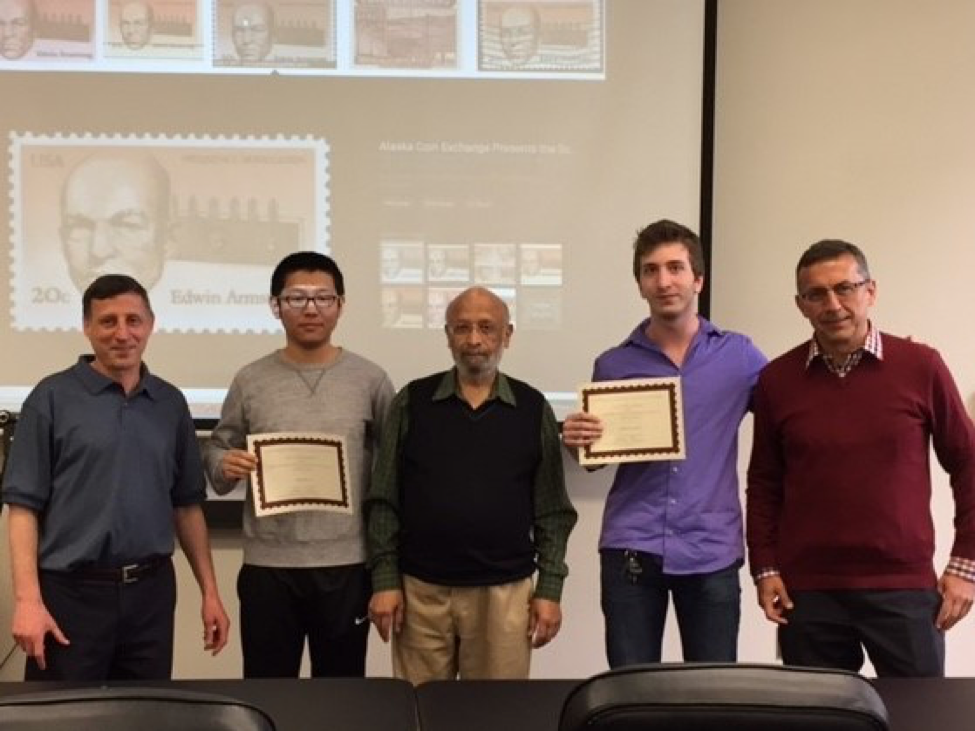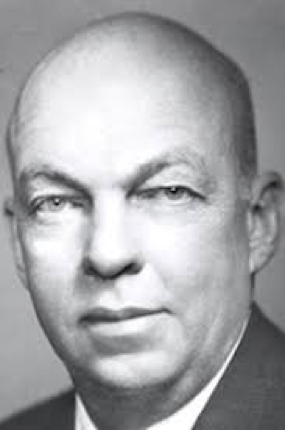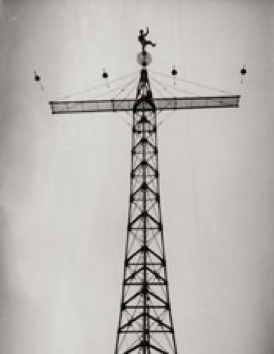Armstrong Memorial Research Foundation Awards
to Two Stony Brook ECE Students

From left: Ridha Kamoua (Undergraduate Program Director), Weicheng Liu (Graduate Student), Jayant P. Parekh, Matthew Dowling (Undergraduate Student), and Petar Djuric (Department Chairman)
Two students in the Stony Brook Electrical & Computer Engineering (ECE) Department, one undergraduate and the other graduate, were given Armstrong Memorial Research Foundation (AMRF) Awards at a special event in the Department on May 23, 2017. The awards were given to the students for excellence in high GPA achievement. Each award consisted of a certificate together with a check for $1,000. The undergraduate awardee is Matthew Dowling, and the graduate awardees is Weicheng Liu.
The awards were given out by Prof. Jayant P. Parekh, who is also the Vice President of the AMRF. Two universities, Columbia University and Stony Brook University, are represented on the Board of Directors of the AMRF, and are recipients of funding from the Foundation which makes possible the awards given out every year.
The Foundation called the Armstrong Memorial Research Foundation (AMRF) is based at Columbia University, and is named after the pre-eminent radio engineer Edwin Howard Armstrong (1890 – 1954) who, through his extraordinary and revolutionary inventions in the field of radio engineering, indisputably ranks among the greatest scientists in human history. Armstrong’s research and inventions took place largely at Columbia University where he originally went in as an undergraduate student, and later ended up becoming a Professor, in the Electrical Engineering Department.
 Edwin Howard Armstrong
Edwin Howard ArmstrongThe mission of the AMRF is to celebrate and memorialize the genius and achievements of Armstrong who may well be described as a luminary in the galaxy of radio engineering inventors. Armstrong was an extraordinary and rare tinkerer who combined profound intuition and analytical skills with an astonishing level of confidence, persistence and focus in his work. These qualities enabled him to make transformative and epoch-making inventions in the field of radio engineering that rapidly advanced the performance and wide-spread popularity of the AM radio followed a few years later by his grandest invention of all, namely, FM radio. His childhood dream of becoming a famous scientist came to fruition during his undergraduate years at Columbia University, and the achievements only grew from there. One of his remarkable traits was he had no compunction or fear in undertaking a study that most people would shy away from because of the complexity of the subject.
Armstrong’s first major invention was the so-called regenerative circuit which in today’s world is commonly called a positive feedback amplifier. This invention came about in 1912 while he was a still just an undergraduate! The invention of the positive feedback amplifier was a major development in the world of radio because it made long-distance AM transmission possible. His patents just on this invention made him a rich man, with more riches to follow with more and even more impactful inventions in the following years.
 Fearless Armstrong atop RCA’s 115-foot antenna tower which stood on the roof of the
21-story Aeolian Hall in Midtown Manhattan
Fearless Armstrong atop RCA’s 115-foot antenna tower which stood on the roof of the
21-story Aeolian Hall in Midtown ManhattanFive years later, in 1917, during World War I, he invented the superhetrodyne receiver which provided an unprecedented improvement in the quality of radio reception at higher frequencies. He heterodyned or mixed in a nonlinear device called a mixer the high-frequency rf signal picked up by the radio antenna with a signal from a local oscillator, thereby producing two output signals, one with frequency equal to the sum of the frequencies of the two input signals and the other with frequency equal to the difference of the frequencies of the two input signals. In the superheterodyne receiver system, the sum frequency signal is filtered out and the lower difference frequency signal (called the intermediate frequency or IF) is then detected with the superior and much simpler low-bandwidth IF detection techniques. The prefix “super” in superheterodyne refers to the fact that the IF frequency is kept constant as one tunes from one radio station to another. This is accomplished by changing the frequency of the local oscillator so that the frequency difference between the rf signal of a radio station and the local oscillator is kept constant. Subsequent to its use in radios, the superheterodyne technique is widely used in microwave measurements where, instead of making measurements directly at microwave frequencies, which is much harder to do, one simply shifts the frequency of the microwave signal to a much lower IF frequency where measurements are much easier and relatively inexpensive.
 The top right of the USPS 1983 Inventors Stamp Series is dedicated to Edwin Howard
Armstrong
The top right of the USPS 1983 Inventors Stamp Series is dedicated to Edwin Howard
Armstrong The invention in 1933 of FM (frequency modulation) radio is Armstrong’s grandest invention which propelled the world of high-fidelity broadcasting to lofty heights. The main advantage of FM over AM in broadcasting is that FM, unlike AM, affords a vastly enhanced immunity to noise. Subsequent to the emergence and success of the FM radio, many applications of Armstrong’s invention of FM radio have emerged in modern communication systems outside of the broadcast industry. One such widespread use of FM is in the area of high performance pulsed radars called pulse-compression radars where the conflicting requirements of long range and high resolution are realized by having the radar antenna radiate out a linear FM pulse and then the return echo is passed through a matched dispersive delay line, thereby producing a separated compressed pulse for each echo representing a different target such as an aircraft. The use of SAWs (surface acoustic waves) on piezoelectric substrates for the generation of a linear FM pulse, and also for the implementation of dispersive delays lines required in pulse-compression filters, provides a popular, compact, high-performance, low-cost and mature technology which is widely used today. SAWs and their applications are discussed in detail in Ref. 6.
References
- Web-site of the AMRF, armstrongmemorialfoundation.org
- Lewis, Empire of the Air: The Men Who Made Radio (HarperCollins, 1991)
- Schwartz, Armstrong’s invention of noise-suppressing FM [History of Communications], Communications Magazine, IEEE, vol. 47, No. 4, pp. 20-23, April 2009
- The Legacies of Edwin Howard Armstrong (The Radio Club of America, 1990)
- Yannis Tsividis, Edwin Armstrong: Pioneer of the Airwaves, in Columbia Magazine, Spring 2002.
- J. P. Parekh, Microwave acoustics, in Fundamentals Handbook of Electrical and Computer Engineering, Vol. 1 (John Wiley & Sons, 1982)
